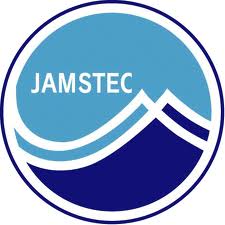I was in the perfect position to serve as the bridge of collaboration between Japan and the USA. My roots are in Japan and I was born in Hawaii, which is strategically positioned between our two countries. I still remember a panel I moderated more than a couple of decades ago when the relationship between Japan and USA was getting testy. Herman Kahn had predicted that the next emerging superstate, Japan, would become #1. Then, eureka, a thought occurred to me: it was important that our #1 and #2 nations take the high road to cooperation, and, as "Takahashi" means high bridge, it is clear that I was fated to be this interface. It did get a lot of laughs.
At around this time I was playing around with my family crest (kamon or mon), added a few colors and came up with:
I used that hybrid art form for my book covers. That rainbow over the ocean linking countries represents every thing I've been trying do during my career.
Note that I used the past tense. My time is coming to an end. Today I had lunch (note my onaga with a glass of Chardonnay) with the next generation to carry on this partnership:
They are from the left, Remi Ie, Mike Rogers and Julie Rogers. They all speak fluent Japanese and English. Remi is with the relatively new Okinawa Institute of Science and Technology. (OIST). Their board includes five Nobel laureates, and Jonathan Dorfan, former director of the Stanford Linear Accelerator Center, is the new president. Their graduate program involves international students. There are no departments and everything is interdisciplinary. Terrific, something I've long advocated! I think that's the campus, located at Onna near the East China Sea. I hope to visit in the Fall.
According to Remi, one prime focus will be ocean development. She expressed keen interest in the Blue Revolution. I glanced at the names on the board and saw only scientists, including a couple who I've fenced with in the past, for they primarily advocated monitoring, modeling and preservation. They controlled the budget and, well, guess who prevailed. I hope this Institute can transcend the model used by the National Oceanic and Atmospheric Administration and National Science Foundation, which focuses on fundamental ocean science, with token engineering and almost no actual development. Makes no sense, for NOAA reports to the Department of Commerce. I underscore this point because the Japan Agency for Marine-Earth Science and Technology Center (JAMSTEC) also does only science. The technology part is engineers making instruments and habitats for scientists. What has been almost befuddling to me is that I was quite close to a couple of JAMSTEC chairmen, both engineers from industry, and they still adhered to the NOAA/NSF priorities. You'd think Japan, of all the countries, would want to commercialize future technologies. They do, but not in the ocean. OIST will hopefully be an enlightened pioneer.
Well, 'nuff for that. Mike Rogers has taken over the role handled by Guy Toyama at the Friends of the Natural Energy Laboratory of Hawaii, and appears to be interested in hydrogen. Remi, Mike and I also talked about Rainbow Pearls International. Julie just returned from Bhutan and is now linked with the East-West Center. Henk Rogers, founder and chairman of Blue Planet Foundation, is the dad of Mike and Julie.
-






















0 comments:
Post a Comment